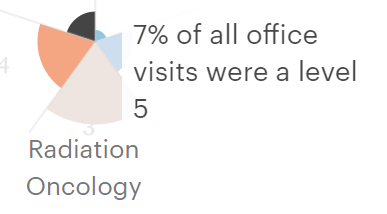How do you spend 40 minutes on a post op early stage breast or bone met or brain met or preop rectal or early stage lung or definitive lung or ... frankly pretty much everything except prostate cancer? Interesting how doctors have such different approaches.
Well, I don't have a resident, and I've seen errors in other docs H&Ps, so I always, 100% of the time, confirm the important pieces of a history first. Now, in part because I am not that busy, if a patient wants to tell the story themselves, I usually let them (which is different than during a busy clinic day in residency). I'd say at minimum that's 5-15 minutes of the interaction, dependent on the patient.
Post-op early stage breast is one of the longer consults. Anything where there is an option and not a single right answer, is easily 35-40 mins face to face, IMO. Bone met, sure could be faster. Brain met, gotta discuss WBRT vs SRS +/- surgery. pre-op rectal has a huge difference in two very good tx options - and gotta discuss sequencing of chemotherapy. Early stage lung - discuss why they aren't a surgical candidate, talk about historical RT. Definitive lung - why don't patients require surgery?
Getting back to post-op early stage breast, just so folks can see my thought process here:
In history - was it a screening mammo or did patient feel a mass? When was previous mammo that was negative? Confirm the location as patient understands if unclear from clinic-obtained records/imaging. Where does patient live? How far is that from my location? Can they drive themselves or are they dependent? What's their family support system like? Do they have major symptoms that they want to talk about? If they do have sx unrelated to cancer, then need to discuss how it's important to them and we'll come up with a plan for those but not something I can take care of at this moment (if applicable). Obviously major PMH stuff - previous RT, pregnancy status, pacemaker/AICD. all the other past medical/social/allergies/meds/family ihstory etc is done by nursing but I clarify important things as necessary.
Discuss historically that RT was 5-6 weeks. Sets the precedent that we are trying to go faster. Do physical exam as it determines comfortability for me for APBI vs WBI. Discuss APBI vs WBI. This is a huge time sink as patients think there's a catch of 30/5 vs 40-42.56 in 15-16, like there's some hidden reason they aren't getting 3 weeks of RT. If not a candidate for APBI, then say why not.
God forbid they're 65 or older, then gotta discuss consideration of omission of RT as it's just a LR benefit and not an OS benefit - try and figure out patient preference, are they balls to the wall about preventing recurrence, or are they "do the least possible that won't kill them" or are they somewhere in the middle. Discuss if they are going to omit RT really need to make sure they take their hormonal therapy even if it makes them feel like crap. Discuss the inevitable question about doing RT but skipping hormonal therapy - "we don't know explicitly in your age scenario, but it seems like it would be somewhat similar to do RT rather than hormonal therapy based on older studies that didn't separate out based on age, but in those studies combining therapy was still better than doing one or the other"
Discuss process of radiation including CT scan, immobilization technique, time from CT scan to start of treatment. Plan for dates and times for CT sim and start of tx. Talk about how RT doesn't feel like anything, feels like an x-ray or CT scan (depending on treatment technique)
Discuss side effects. Re-assure this is worst case scenario. Discuss late side effects, re-assure that most of these are rare. Answer questions. Ask if there are more questions. Sign consent if appropriate and patient willing to. Give cards to patient and visitor if present. Ask if there are more questions. Discuss that if there are future questions to just have patient/family member call my office.
How does going through all this get done in less than 35-40 minutes, while still having a conversation with the patient (and not doing a monologue where there's no space for the patient to ask a question)? I suppose it's possible.
Maybe folks are just way faster than I am. Maybe I massage the numbers a bit by asking patients about non-clinical stuff as noted above. Maybe given I'm not that busy I'm willing to just shoot the **** with patients if I'm not running aroung like a chicken with my head cut-off. Maybe I have the time to just let patients get all their questions out and answer them in a complete fashion, rather than having to rush them due to an overbooked clinic schedule as I did at times during residency - those things don't change the plan but it, IMO, makes patients feel more comfortable with their treatment option.
Not sure how i could spend that much time with a skin ca consult honestly
In fairness the one level 4 I billed based on time was an intact cutaneous skin cancer patient with dementia who couldn't really verbalize much so I mostly just spoke to the family member who was the POA.


